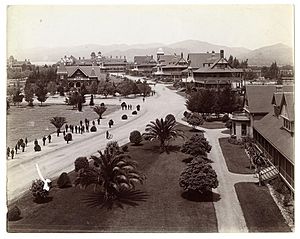Sawtelle Veterans Home facts for kids
The Sawtelle Veterans Home was a special place in Los Angeles for American veterans who needed care. It was like a home where soldiers, sailors, and others who served their country could live if they were disabled or couldn't support themselves. This home, officially called the Pacific Branch of the National Home for Disabled Volunteer Soldiers, started in 1887. It was built on a large piece of land in California that was given by Senator John Percival Jones and Arcadia Bandini de Stearns Baker. Over time, the home grew bigger, even adding a special cemetery for veterans. A new hospital was built in 1900, and later, a bigger one opened in 1927, which is now known as the West Los Angeles VA Medical Center.
Contents
A Home for Soldiers
After the American Civil War in 1865, the United States government created a new organization to help soldiers and sailors who had volunteered to fight. Before this, only regular army and navy members had special homes. This new law, signed by Abraham Lincoln, meant that the country would now directly help its temporary soldiers. This organization was first called the National Asylum for Disabled Volunteer Soldiers and Sailors. Later, in 1873, it was renamed the National Home for Disabled Volunteer Soldiers (NHDVS), but many people just called it the Old Soldiers Home. Between 1867 and 1929, this "Home" grew to have ten different locations across the country.
A group of managers ran the Home. They decided where to build new branches and what services to offer. Even though important people like the President and the Chief Justice were involved, the Home was mostly independent from the main government. This allowed it to make its own decisions about how to best care for veterans.
Over the years, more and more veterans became eligible to live at the Home. By 1900, any honorably discharged officer, soldier, or sailor who had served in any war and was disabled or couldn't earn a living could apply. This even included those who fought in the American Indian Wars and later, veterans from the Philippines, China, and Alaska.
The Pacific Branch Home
Because so many more veterans could now join, the government decided in 1887 to open a new branch of the Home on the West Coast. This new branch, called the Pacific Branch, was built west of the Rocky Mountains.
Land for the Home
Many towns wanted the new Home because it would bring prestige and growth. The chosen spot near Santa Monica was picked because people donated a lot of land, money, and water. Senator John P. Jones and Robert S. Baker, along with his wife Arcadia Bandini de Stearns Baker, were key donors. They were developing Santa Monica and believed the Home would help their community grow. Another large piece of land was also donated nearby.
Building the Home
The Pacific Branch officially opened in 1888 on a large area of land. Famous architect Stanford White helped design the first buildings, which were like barracks. Other important buildings included a streetcar depot and a chapel, both built around 1900. A hospital was also built in stages. The land, which was originally treeless, was transformed with many new trees like pines, palm trees, and eucalyptus.
Running the Home
While the main Board of Managers set the rules for all the Homes, many daily decisions were made by local managers and governors at each branch. These local leaders helped make sure the Pacific Branch ran smoothly.
Some important people were associated with the Pacific Branch, including:
- Nicholas Porter Earp: He died at the Home in 1907.
- Hermann Edward Hasse: He was the chief surgeon at the Home for many years.
- Liver-Eating Johnson: A famous frontiersman and Union Soldier who died at the Home in 1900.
The Town of Sawtelle
The Pacific Branch became a popular spot for both tourists and people looking to buy land. In 1904, a special streetcar tour called the "Balloon Route" even stopped at the Home. A new community called Sawtelle grew up around the Pacific Branch. This happened because veterans' families and veterans themselves, who were receiving support, settled nearby.
James W. Wadsworth Hospital
After World War I, a new government group called the Veterans Bureau was created to help the many younger veterans who needed hospital care and rehabilitation. This led to a lot of new construction in the 1920s. The James W. Wadsworth Hospital opened in 1927, replacing the older Barry Hospital.
Veterans Administration
In 1930, the National Home and the Veterans Bureau were combined into one big organization called the United States Veterans Administration. This new group planned to build even more facilities. The current Wadsworth hospital building was constructed in the late 1930s. Many of the older buildings from the 1890s were taken down in the 1960s. The main Veterans Affairs (VA) hospital building, now known as the West Los Angeles VA Medical Center, opened in 1977.
VA West Los Angeles Medical Center
Today, the West Los Angeles VA Medical Center is a large hospital that provides many different health care services to veterans. It is part of the VA Greater Los Angeles Health Care System and is one of the biggest VA health care campuses.





